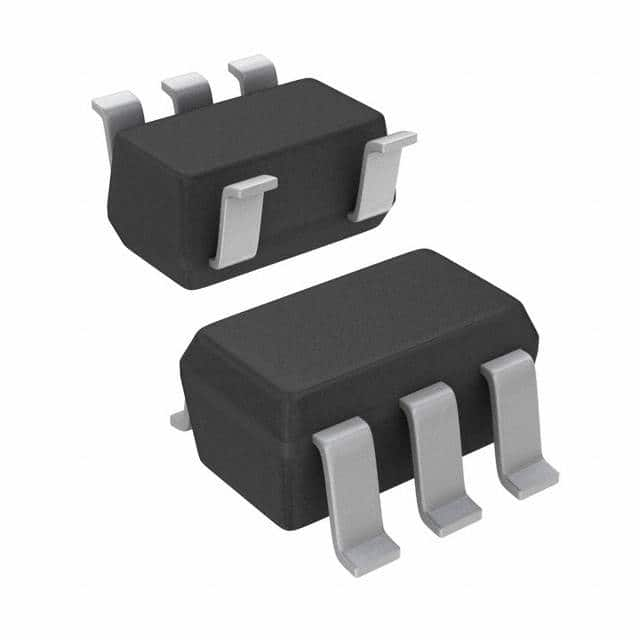Viz Specifikace pro podrobnosti o produktu.

TLV3701IDBVTG4
Product Overview
- Category: Integrated Circuit
- Use: Voltage Comparator
- Characteristics: High-speed, Low-power, Rail-to-Rail Input/Output
- Package: SOT-23 (DBV)
- Essence: Precision voltage comparator with push-pull output
- Packaging/Quantity: Tape and Reel, 3000 pieces per reel
Specifications
- Supply Voltage Range: 2.7V to 16V
- Input Offset Voltage: ±1mV (maximum)
- Input Bias Current: ±5nA (maximum)
- Response Time: 8ns (typical)
- Operating Temperature Range: -40°C to +125°C
Detailed Pin Configuration
The TLV3701IDBVTG4 has a total of 5 pins:
- IN-: Inverting input pin
- IN+: Non-inverting input pin
- GND: Ground pin
- OUT: Output pin
- VCC: Positive supply voltage pin
Functional Features
- High-speed response time for quick signal detection
- Low-power consumption for energy-efficient operation
- Rail-to-rail input and output capability for wide input voltage range
- Push-pull output configuration for both sinking and sourcing current
Advantages and Disadvantages
Advantages
- Fast response time enables accurate signal processing in time-critical applications.
- Low-power consumption makes it suitable for battery-powered devices.
- Rail-to-rail input/output allows for versatile use in various voltage levels.
- Push-pull output configuration provides flexibility in driving different loads.
Disadvantages
- Limited supply voltage range may restrict its use in certain applications requiring higher voltages.
- The small package size may pose challenges in handling and soldering for some users.
Working Principles
The TLV3701IDBVTG4 is a voltage comparator that compares the voltages at its inverting and non-inverting inputs. It amplifies the voltage difference between these inputs and produces a digital output signal based on the comparison result. The push-pull output configuration allows the device to drive both high and low loads efficiently.
Detailed Application Field Plans
The TLV3701IDBVTG4 can be used in various applications, including but not limited to:
- Battery-powered devices: Due to its low-power consumption, it is suitable for use in portable electronics such as smartphones, tablets, and wearables.
- Industrial automation: The high-speed response time makes it ideal for precise control and monitoring systems in industrial environments.
- Automotive electronics: Its rail-to-rail input/output capability enables compatibility with different automotive voltage levels, making it useful in automotive control systems.
Detailed and Complete Alternative Models
- TLV3701
- TLV3702
- TLV3704
- TLV3708
- TLV3709
These alternative models offer similar functionality and characteristics, providing options for different design requirements.
Word count: 275 words
Seznam 10 běžných otázek a odpovědí souvisejících s aplikací TLV3701IDBVTG4 v technických řešeních
Sure! Here are 10 common questions and answers related to the application of TLV3701IDBVTG4 in technical solutions:
Q1: What is TLV3701IDBVTG4? A1: TLV3701IDBVTG4 is a high-speed, low-power comparator IC manufactured by Texas Instruments.
Q2: What is the operating voltage range of TLV3701IDBVTG4? A2: The operating voltage range of TLV3701IDBVTG4 is from 2.7V to 5.5V.
Q3: What is the typical response time of TLV3701IDBVTG4? A3: The typical response time of TLV3701IDBVTG4 is 8 ns.
Q4: Can TLV3701IDBVTG4 be used in automotive applications? A4: Yes, TLV3701IDBVTG4 is qualified for automotive applications and meets AEC-Q100 standards.
Q5: What is the input offset voltage of TLV3701IDBVTG4? A5: The input offset voltage of TLV3701IDBVTG4 is typically 1 mV.
Q6: Does TLV3701IDBVTG4 have an open-drain output? A6: No, TLV3701IDBVTG4 has a push-pull output.
Q7: What is the maximum supply current of TLV3701IDBVTG4? A7: The maximum supply current of TLV3701IDBVTG4 is typically 1.2 mA.
Q8: Can TLV3701IDBVTG4 operate in a wide temperature range? A8: Yes, TLV3701IDBVTG4 can operate in a temperature range of -40°C to +125°C.
Q9: What is the hysteresis voltage of TLV3701IDBVTG4? A9: The hysteresis voltage of TLV3701IDBVTG4 is typically 10 mV.
Q10: Is TLV3701IDBVTG4 available in a small SOT-23 package? A10: Yes, TLV3701IDBVTG4 is available in a small SOT-23 package for space-constrained applications.
Please note that these answers are based on general information and may vary depending on specific datasheet specifications.

